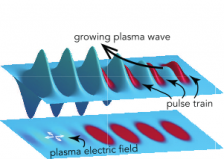Aug 16 2017
A team led by Professor Simon Hooker's group at Oxford have shown that very compact particle accelerators could be driven by trains of laser pulses travelling through a plasma (an ionized gas). This work illustrates the potential for efficient plasma accelerators operating at much higher pulse repetition rates than possible to date.
 Principle of the multi-pulse laser wakefield accelerator. Each pulse in a train of low energy laser pulses (red) drives its own plasma wave (blue). These waves will add coherently if the laser pulses are spaced by the wavelength of the plasma wave. The variation of the electron density within the wave generates large electric fields which can be used to accelerate charged particles. In this cartoon only four laser pulses are shown, whereas a working MP-LWFA would use a train of 10 – 100 pulses. (Credit: University of Oxford)
Principle of the multi-pulse laser wakefield accelerator. Each pulse in a train of low energy laser pulses (red) drives its own plasma wave (blue). These waves will add coherently if the laser pulses are spaced by the wavelength of the plasma wave. The variation of the electron density within the wave generates large electric fields which can be used to accelerate charged particles. In this cartoon only four laser pulses are shown, whereas a working MP-LWFA would use a train of 10 – 100 pulses. (Credit: University of Oxford)
In a plasma accelerator an intense laser pulse forces the plasma electrons out of its way to form a trailing electron density wave (or “plasma wave”). The electric fields generated within this density structure are about 1000 times stronger than those within a conventional accelerator, and since they move with the driving laser pulse they can be used to accelerate relativistic charged particles.
Electron beams with particle energies of a few GeV, similar to those used at large-scale synchrotron facilities, have already been generated by laser-plasma accelerator stages only a few centimetres long. However, the lasers used are inefficient (the “wall-plug” efficiency is less than 0.1%) and can only operate a few times per second.
In 2014 the Oxford group, and colleagues, proposed that a large amplitude plasma wakefield could be driven by a train of low-energy laser pulses. In this “multi-pulse laser wakefield accelerator” (MP-LWFA), each laser pulse drives its own wakefield. If the laser pulses are spaced by the wavelength of the plasma waves (determined by the plasma density), these will add coherently so that the amplitude of the plasma wave grows towards the back of the pulse train.
The MP-LWFA approach allows the use of emerging laser technologies which cannot easily generate short, high-energy laser pulses, but which could generate thousands of pulse trains per second, and with a wall-plug efficiency > 10%.
In the new work – performed at the Central Laser Facility, Rutherford Appleton Laboratory – these ideas were tested by measuring the amplitude of plasma waves driven by trains of up to 7 laser pulses. As reported in Physical Review Letters, the wakefield amplitude increased sharply when the resonance condition was met.
The team also demonstrated the potential for a future "energy-recovery" plasma accelerator by showing that a trailing, out-of-resonance laser pulse could remove unused wakefield energy. The energy is extracted via blue-shifting of the laser pulse, and in principle could be recycled. This ability could be important in future plasma accelerators generating high average beam currents.